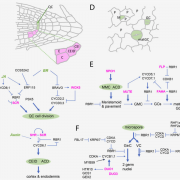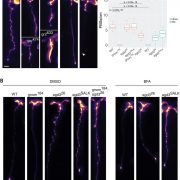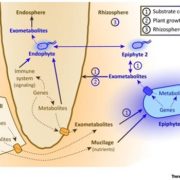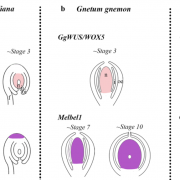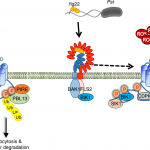Morphology, molecular development and ecological function of pseudonectaries on Nigella damascena petals (Nature Comms)
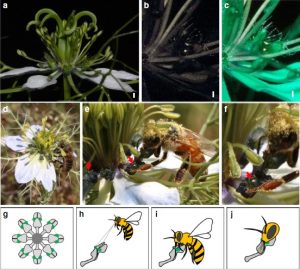 Pseudonectaries do not secrete nectar like nectaries. So, what are their ecological functions? Are there any morphological and anatomical differences between them and true nectaries? How do they develop and evolve? Liao et al. examined pseudonectaries of Nigella damascene to answer these questions. The epidermis of N. damascene pseudonectaries is composed of polygonal cells with smooth and grainy surfaces, which are shiny and reflective and thus attract the attention of honey bees. The development of pseudonectaries strongly coincided with the ectopic expression of the abaxial gene NidaYAB5, and knockdown of the gene resulted in the lack of pseudonectaries and less attractive flowers, significantly decreasing both the visit frequency and probing time of honey bees. Genes related to cell division, chloroplast development, and wax formation were also associated with pseudonectary formation. Overall, pseudonectaries attract suitable pollinators and also guide their visit by marking the entrance of the nectar chamber. (Summary by Elisandra Pradella @Elisandra_MP) Nature Comms. 10.1038/s41467-020-15658-2
Pseudonectaries do not secrete nectar like nectaries. So, what are their ecological functions? Are there any morphological and anatomical differences between them and true nectaries? How do they develop and evolve? Liao et al. examined pseudonectaries of Nigella damascene to answer these questions. The epidermis of N. damascene pseudonectaries is composed of polygonal cells with smooth and grainy surfaces, which are shiny and reflective and thus attract the attention of honey bees. The development of pseudonectaries strongly coincided with the ectopic expression of the abaxial gene NidaYAB5, and knockdown of the gene resulted in the lack of pseudonectaries and less attractive flowers, significantly decreasing both the visit frequency and probing time of honey bees. Genes related to cell division, chloroplast development, and wax formation were also associated with pseudonectary formation. Overall, pseudonectaries attract suitable pollinators and also guide their visit by marking the entrance of the nectar chamber. (Summary by Elisandra Pradella @Elisandra_MP) Nature Comms. 10.1038/s41467-020-15658-2
[altmetric doi=”10.1038/s41467-020-15658-2″ details=”right” float=”right”]



